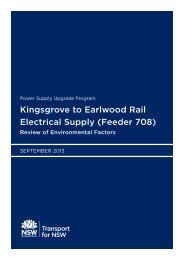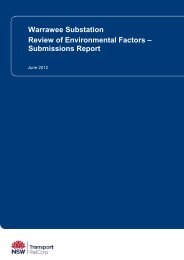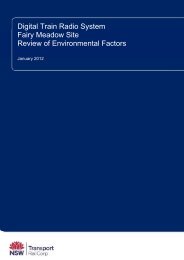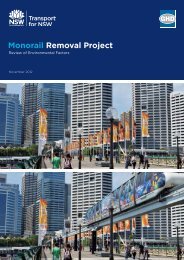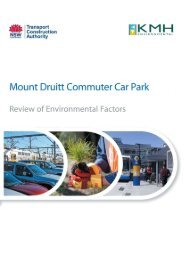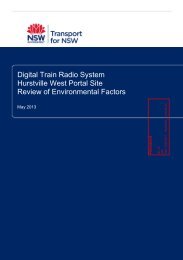Warrawee Substation - Review of Environmental Factors
Warrawee Substation - Review of Environmental Factors
Warrawee Substation - Review of Environmental Factors
- No tags were found...
Create successful ePaper yourself
Turn your PDF publications into a flip-book with our unique Google optimized e-Paper software.
Scientific Name Common Name TSC/FMActEPBC Act Habitat Association Nature <strong>of</strong> Record Likelihood <strong>of</strong>occurrencePotential for impactsMixophyes iteratus Giant Barred Frog E E Occurs on the coast and ranges from south-easternQLD to the Hawkesbury River in NSW, particularlyin C<strong>of</strong>fs Harbour - Dorrigo area. Forage and liveamongst deep, damp leaf litter in rainforest, moisteucalypt forest and nearby dry eucalypt forest. Breedin shallow, flowing rocky streams. Within SydneyBasin, confined to small populations in tall, wet forestin the Watagan Mountains north <strong>of</strong> the Hawkesburyand the lower Blue Mountains (White 2008b).Predicted to occurwithin 10km(DSEWPaC 2012a)Unlikely.No suitable streamhabitats.Nil.HeleioporusaustraliacusGiant BurrowingFrogV V Occurs along the coast and eastern slopes <strong>of</strong> theGreat Dividing Range south from Wollemi NationalPark. Appears to exist as 2 populations with a 100kmgap in records between Jervis Bay and Eden.Northern population occurs on sandy soilssupporting heath, woodland or open forest. Breeds inephemeral to intermittent streams with persistentpools. Only infrequently moves to breeding sites,most commonly found on ridges away from creeks,several hundred metres from water.25 records within10km (OEH2012a)Predicted to occurwithin 10km(DSEWPaC 2012a)Unlikely.No suitable habitat.Nil.Litoria aureaGreen and GoldenBell FrogE V Formerly occurred from Brunswick Heads to Victoria,but >80% populations now extinct. Inhabits marshes,natural and artificial freshwater to brackish wetlands,dams and in stream wetlands. Prefers sites containingcumbungi (Typha spp.) or spike rushes (Eleocharisspp.), which are unshaded and have a grassy areaand/or rubble as shelter/refuge habitat nearby.Gambusia holbrooki is a key threat as they feed on6 records within10km (OEH2012a)Predicted to occurwithin 10km(DSEWPaC 2012a)Unlikely.No suitable wetlandhabitats.Nil.



